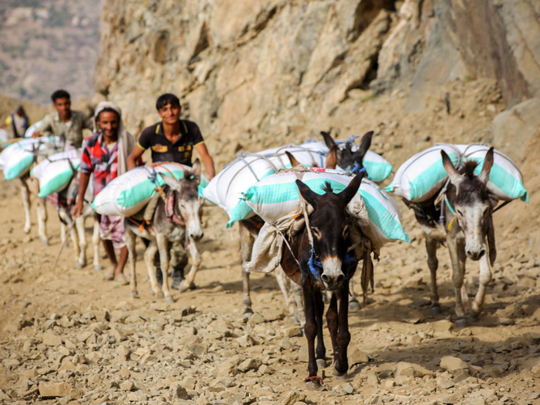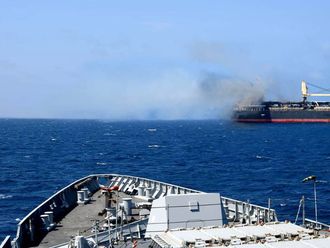
Taiz: Struggling under the weight of gas canisters, plastic sacks and cardboard crates stuffed with necessities, residents of Yemen’s Taiz have taken to treacherous mountain paths to bring essential goods into their besieged city.
Men and women, old and young, pick their way along a jagged path leading to Taiz, where a months-long siege by Al Houthi rebels has left even basic items in desperately short supply.
The weakest among them load their goods onto camels and donkeys. But even for sturdy beasts of burden the journey is a difficult one, as they trip and stumble over the rocks jutting out along the way.
A donkey collapses and a crowd descends on it, rushing to put it back on its feet.
Exhausted, like its master, the donkey starts back along the path towards a neighbourhood of Taiz at the bottom of the mountain.
The 600,000 residents of the southwestern city are in desperate need of everything.
They have been caught in the crossfire between loyalists to Yemeni President Abd Rabbo Mansour Hadi who are defending their positions in Taiz and the Al Houthis who have encircled them.
Residents say humanitarian aid that the United Nations ordered to be distributed never reached them, so more are taking to the mountain paths to bring it in by foot.
“We are trying to deliver these food products to Taiz to lighten the suffering of the besieged residents,” said Adel Al Shabie, who lives in the city.
He blames the Al Houthis and their allies, troops who remained loyal to former president Ali Abdullah Saleh, for the residents’ suffering.
“The Al Houthis and Saleh’s supporters are blocking the roads,” he said.
“Now we are forced to cross the mountains”.
Even though they are used to the mountainous terrain around the city, the rocky path, surrounded by ravines, is hard going for the residents.
“When you’re weighed down with goods, it’s hard to catch your breath as you take the path down from the mountain,” said Omar Hazaa, puffing and panting as he took a break from the journey.
“As you can see, the road is rocky. We have to cross six kilometres under a burning sun. We are hungry and we are thirsty,” said Sultan Abdo, another resident.
The region has become the scene of daily fighting and bombardments as rebels and loyalists grapple for control of the city.
Snipers are another threat that civilians in the city and humanitarian volunteers have to face.
Al Houthis, from Yemen’s north, seized Sana’a last year and then advanced south to the second city of Aden, forcing Hadi to flee to Saudi Arabia in March.
The conflict has escalated dramatically since Saudi-led air strikes began in March, with more than 5,800 people killed and 27,000 wounded since then, according to UN figures.
On December 17, the UN announced an agreement between the warring parties in Yemen, which was supposed to “allow for a full and immediate resumption of humanitarian assistance” into the city.
The UN said on December 18 that more than 100 trucks of food aid had arrived in Taiz, but local NGOs and sources close to Hadi said rebels seized the aid and distributed it in areas under their control.
For many, the shortages continue and exhausted residents are still winding their way along the treacherous mountain paths to bring food into the war-weary city.












